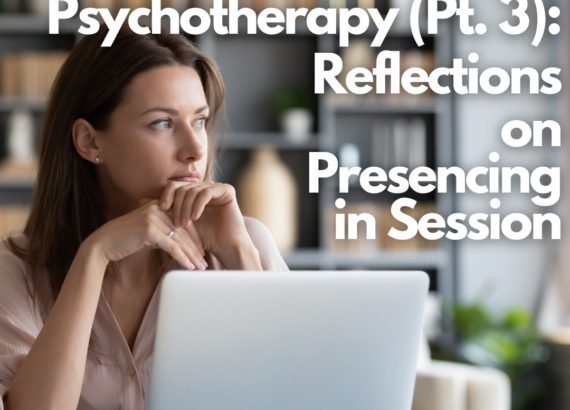Evidence-Based Psychotherapy: Advantages & Challenges (24)

Evidence-Based Psychotherapy: History
- The phrase “evidence-based” wasn’t used until the 1980s
- “Evidence-based medicine is the conscientious, explicit, and judicious use of current best evidence in making decisions about the care of individual patients” (8:27)
- Further work was done by the APA to make evidence-based psychotherapy the standard
Academic Idealism vs Clinical Application
- Ideally, this should be a very collaborative experience
- Based on the previous definition, this would require the therapist to be aware of a large number of components
- Including the ability to inform the client of the current research.
- Also, this may create a power dynamic that can be contradictory
- Because the client sees the therapist as the professional they should listen to
- “I agree with the posturing of collaboration being kind of open. But then, immediately when you start looking at the application and embodiment of this posture, evidence-based therapies and psychotherapies coming from a medically-oriented paradigm gets muddy very quickly” (17:31)
Evidence-Based Psychotherapy: Advantages
- EBTs are important because they can provide a template that can be built upon and tailored to each client
- Additionally, therapists that use EBTs can save time and resources
- EBTs are associated with more accountability
- And enhancing the health and well-being of the public
- Keep in mind, however, that if the research goal was to prove these advantages, the results could be problematic.
Evidence-Based Psychotherapy: Challenges
“Sometimes we can’t quantify what it takes to treat a human.”
- Predominately left-brained
- It’s possible that therapists adhere less to EBTs over time
- Additionally, therapists may not be up to date on current research
- The outcomes of trials differed from real-world clinical practices
- Because the controlled trials didn’t account for certain dynamics or co-morbidities
- Contrary to the trials’ focus, people may be coming to therapy to do more than just eliminate their symptoms
- “Reliance on scientific research is problematic; as for many practices, the level of evidence required to be considered “evidence-based” is lacking or unattainable” (30:13)
Evidence-Based Psychotherapy: Misconceptions
- EBTs are not “cookbook instructions” for therapists to practice
- But are more of a “map of potential routes” for the therapist to take
- Many think psychotherapy provided can never meet EBT standards
Evidence-Based Psychotherapy: Implementation and Application
“The art of therapy does not have to be in contradiction with the science of therapy.”
- Objective perfection in psychotherapy is nearly impossible and likely unhelpful.
- Rather, let’s aim for subjective curiosity and an invitation to practice in an evidence-based way.
- Structured curiosity takes the posture of “yes and…”
- It allows you to transcend and include, to go from left to right, from fidelity to flexibility.
- The focus of Evidence-Based Psychotherapy may be shifting away from the product and toward the process
- There are various factors associated with optimal implementation:
-
Relationships
- A positive therapeutic relationship significantly contributes to the healing process
- But, be wary of providing treatment that revolves around the therapists’ goals
- Additionally, there is no one-size-fits-all approach
- Therapist centric vs client centric
-
Fidelity
- High fidelity is associated with good therapeutic outcomes
- Importantly, the core components of the EBT are implemented
- Yet, rigid application of fidelity reduces the usability of a particular psychotherapy
-
Flexibility
- Flexible implementation is necessary
- This means deviating from the protocol in some ways
- Remember, it’s always client-dependent.
-
Context
- The authenticity of the provider is important
- Also, the applicability to the client
-
Provider
- The provider needs to consider what the client needs
- Additionally, connection needs continued learning
- Embracing curiosity and creativity is essential to the longevity of the practitioner’s spirit
-
Season 2 Articles
Did you know? After full completion of Beyond Healing Institute’s Somatic Integration and Processing training, each participant can receive 21 NBCC hours.
Beyond Healing Center
- Visit our website for all things BHC
- Contact us about retreats and therapy
- Contact us about training and consultation
Beyond Healing Media
- First, listen to our past episodes of EBT here
- Then, check out more Beyond Healing podcasts
- Give your support and gain access to exclusive content through Patreon
Interested in supporting a child?
- https://www.patreon.com/BurntOutEducator
- 100% of the proceeds donated to the Burntout Educator will provide therapy for a child in the public school system.
- Not therapy capped at a certain number, but an open-ended relationship with a highly qualified therapist in the BHC network.
Connect with us on social media: Facebook & Instagram
Credits
Executive Directors: Jennifer and Ryan Savage, Melissa Bentinnedi, Bridger Falkenstein
Hosts: Bridger Falkenstein, Caleb Boston, and Melissa Benintendi
Filmographer: Tyler Wassam
Podcast Editor: Jamie Eggert
Original Music Composers: Bridger Falkenstein and Caleb Boston
Show Notes: Jamie Eggert & Jordan Murray
Podcast: Play in new window | Download




Comments
Trackbacks & Pingbacks
[…] what does ginseng do for a man’s body […]
[…] rybelsus cost […]